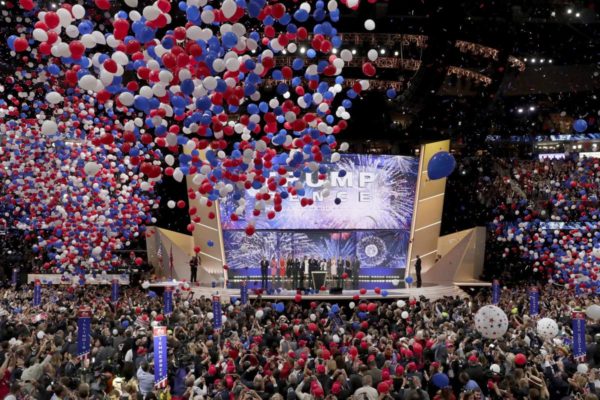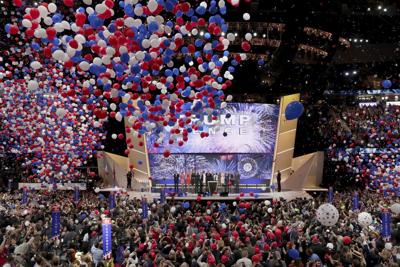What presidential candidates do Illinois delegates support? Here’s how it works.

Then-candidate Donald Trump is shown on stage at the GOP Convention in Cleveland in July 2016. Illinois will send 184 Democratic delegates and an estimated 67 Republican delegates to the parties’ respective 2020 conventions.
Dan McNeile
SPRINGFIELD — In presidential primary elections, it’s all about the delegates.
Delegates are the chosen representatives who attend each party’s nominating convention and give their support to a specified candidate.
A Democratic candidate this year will need 1,990 of 3,979 pledged delegates at the party’s national convention to receive the nomination on the first ballot, while any subsequent ballots will require 2,376 of all 4,750 delegate votes.
Republicans require a majority of the party’s 2,551 delegates to win the nomination.
Illinois will send 184 Democratic delegates and an estimated 67 Republican delegates to the parties’ respective conventions. Of those, 101 Democratic delegates and 54 Republican delegates will be decided in the state’s primary elections on Tuesday, March 17.
In Illinois, delegate candidates submit their names to the Illinois State Board of Elections and must also declare their support for a presidential candidate in that process. Per each party’s rules, the delegates are bound to support the candidates they pledge themselves to unless the candidate drops out of the race.
On the ballot, voters will see the delegate’s name along with the candidate they have pledged their support to, but the parties each have a different process for how the delegates are allocated.
The democratic process
The Democratic National Committee revamped its delegate allocation rules after the 2016 elections by centering the nominating process on the pledged delegates whose votes are earned in the primaries.
Of the 184 delegates Illinois will send to the Democratic National Convention in Milwaukee from July 13-16, 155 will be pledged delegates allotted based on primary votes. All candidates receiving at least 15 percent of the vote are eligible for these delegates.
The pledged delegates are broken down into three groups: 101 chosen at the congressional district level in the primaries; 20 “pledged party leaders and elected officials,” or PLEOs, such as mayors and state lawmakers; and 34 at-large delegates. The latter two groups are chosen by the district-level delegates after the primaries. There are also 13 alternate at-large delegates chosen after the primaries.
The other 29 are automatic delegates, including the state’s Democratic members of Congress, former President Barack Obama, members of the DNC and others. They are free to support candidates independent of the popular vote in the state.
They will only come into play, however, if no candidate has the requisite amount of pledged delegates on the convention’s first ballot.
While the automatic delegates, commonly referred to as “superdelegates,” played a larger role in years past, Mary Morrissey, executive director of the Democratic Party of Illinois, said this election represents a change in the party’s philosophy.
“So nowhere in the delegate selection plan that we had to submit to the Democratic National Committee, you will not find superdelegates anywhere in there,” she said. “The closest you get to a superdelegate are the automatic delegates. And those are individuals who become delegates by virtue of their elected party or elected office.”
The 101 district-level delegates are split between the state’s 18 Congressional districts based on the Democratic voter turnout in the previous two presidential elections and the most recent gubernatorial election.
The districts will each send between three and eight delegates to the convention, with Democratic stronghold Districts 1, 7 and 9 receiving eight delegates each and the more conservative District 15 receiving three.
On their ballot, voters in March can choose up to the number of delegates their district sends to the convention. If a candidate earns a delegate by popular vote but does not have one on the ballot, the party can name a delegate after the primaries.
Once it is determined how many delegates a candidate will receive in a given district, the pledged delegates for those candidates will be selected to the convention based on their total votes received and their gender breakdown — each state must send an equal number of male and female delegates to the convention per party rules.
Once those 101 delegates at the district level are selected, they will choose the 20 PLEO delegates, 34 at-large delegates and 13 alternates in April. Those delegates will be allotted to candidates based on the statewide popular vote in the March primary.
“Normally the presidential campaigns kind of orchestrate who they want selected for those positions, they kind of come in with a slate of at-large delegates,” Morrissey said.
Morrissey said seeing a delegate’s name on the ballot, along with the candidate they are pledged to, could prove beneficial for an undecided voter.
“If you can’t decide between these three presidential candidates, but you see that individuals that you trust – whether they be party leaders or elected officials or advocates – are running as delegates for a certain presidential candidate, you can somewhat rely upon people will give more weight to them people will give more weight to them,” she said.
The Republican process
The GOP has two different types of delegates – those elected and those chosen by the party at large. There are 54 elected delegates – three per congressional district – and between 10 and 15 at-large delegates each year. Each of those delegates also has an alternate chosen in the same manner.
While other candidates could have circulated petitions to be placed on the ballot, this year, all 54 delegates on the ballot will be supporting incumbent President Donald Trump at the Republican National Convention, which is scheduled for Aug. 24-27 in Charlotte, North Carolina. That’s by design said Anthony Sarros, the Illinois GOP’s executive director.
“So how we did it this year was, we worked with the Trump campaign, we collected information of anybody who was interested in being a delegate,” Sarros said. “And from there, the Trump campaign selected the three delegates and alternate delegates that they wanted running in those districts.”
While it’s Trump’s party this year, Sarros said in a contested year, winning delegates is often more important than a statewide popular vote win.
“It’s extremely important because these are the folks that are nominating the GOP nominee for president,” he said. “If one person wins the statewide primary and another person wins the majority of delegates, I would see it almost as more of a win for that person who gets more delegates because they are closer to their goal of becoming the nominee for president.”
At-large delegates are chosen at the Illinois state Republican Party convention, which will take place in Peoria from June 11-13 this year, by a committee consisting of one member per each Congressional district.
Sarros said he expects the party to choose 12 of those delegates, as determined by a calculation of the Republican National Committee. The state’s three RNC members – state GOP Chairman Tim Schneider, Illinois national committeeman Richard Porter and national committeewoman Demetra DeMonte – are also de facto delegates to the convention, Sarros said.
The at-large delegates and RNC members are bound to the popular vote winner of the state primary, Sarros said.







